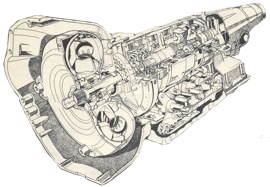Ford Australia had to co-opt its automatic gearboxes from a pool manufacturer who also made gearboxes for BW auto Chrysler Valiants, Leyland Marinas, LandCrab 1800'S, Nomads, Kimberly's, Tasmin's and P76'S. This was to make sure the whole product line had more than 85% local content. Ford in UK for a while (from 1958-1973) had to do the same thing, buy BW gearboxes out of a factory that made BW gearboxes for Hillmans. That's why the Aussie automatic options were so darn strange...
While many Aussie six cylinder 3.3, 3.6 and 4.1 liter Falcons, Fairmont's, Fairlane's and LTD's had C4 based imported Ford pan and case fill automatics from 1966 to 1980, most were Borg Warner Type 35 3-speeds.
Unlike Ford US and its landmark AOD in October 1979, we had to wait almost 13 years for a locally made BTR LE 85, 95, 97 etc 4-stage automatic. The wait was shear agony, as all 3 stage automatic I6 Falcon sixes, even with 162 hp to 186 hp Multi Point EFI , suffered huge half a second or greater performance losses over the quarter mile, and lower highway mpg, all because we couldn't use the performance axle ratios and still get loping 2000 rpm at 65 mph gearing.
The 45 is the smaller Borg-Warner 45 Transmission, which featured one extra cog. 4 speed BW45 auto was introduced in the UK with the Chrysler Avenger in 1972.
But since every Borg Warner trans had a number, easy mistake...

"The Borg-Warner
Type 45 Auto Transmission
In 1972 Borg Warner began producting their Type 45 automatic transmission, although a three-speed version (Model 55) using mostly the same bits as the Type 45 was being produced in Japan for engines of 3-litres. The Type 45 was produced in a new multi-million dollar factory at Kenfig in South Wales (UK), and it represented a then brand new concept. It had two clutches and three brakes to control the operation of three planetary trains all of the multi-disc type. These were complimented by a sophisticated system of hydraulic valves and accumulators, but there were no servos or band brakes, so running adjustments were eliminated.
The Type 45 had a 3.0 to 1 first gear, a 1.94 to 1 second ratio, a 1.35 to 1 third and a direct top with a reverse of 4.69 to one (by making the forward gears close in ratio and therefore much smoother in operation, the high reverse was a direct result). The Type 35 automatic used a 2.39 first, a 1.45 second and a direct top with a 2.09 reverse. The Type 45 selector quadrant followed the conventional sequence of P R N D 3 2 so there was nothing new for the driver to learn. As in the Type 35 and 65, a single mechanical control was used to operate the parking pawl as well as to select the driving range required.
A starter-inhibitor switch and a reverse light switch were provided. But the big news with the Type 45 was the slimness of the all-alloy transmission case and bellhouse, being 3 and a quarter inches narrower than the 35, (247mm as against the Type 35 three-speeds 327mm). This allowed manufacturers to reduce the size of the floorpan - and increase internal space. The overall length increased about one inch to 13in. but weight, despite the extra ratios and the two extra sets of gear trains, remained the same at 112lbs."
http://www.uniquecarsandparts.com.au...icles_1972.htm
Only made for a limit of 162 Nm or 120 lb-ft, and never used on any Ford. It wasn't even man enough for the 1725 Rootes OHV alloy head.
For years, I thought a BW 45b would be the ultimate BW35 replacement in my 4.1 liter Falcon X-flow, but they were totally different...Ford Australia had four domestic Borq Warner Gear/ BTR automatic gearbox families.....
the 3 speed only 1965-1984 BW 35,
the OHV X-flow 1985-1987 BW 40, and then
the also 3-speed only BW 51 in the first 1988-1990 OHC, then
the 1991-onwards 4 speed auto BTR LE 85 variants, a Volvo/Maserati /Musso used trans replaced by Ion.
Whats really complicated is that in 1966, Ford Australia changed the Bellhousing to the pre 1966 289 SBF/ Volvo 144/164 flexplate size, and a non US type of High Mount, and the flexplate is interchangable with the 157 SBF ring gear, but the bellhousing is different.
In 1988, the OHC went to a 265 Hemi Valiant style LHS starter bellhousing, but the OHV X-flow was still being made till 1993 with the old 66 onwards Aussie Ford bell.
There were a few changes, but its basically stayed similar to the 88 pattern for the last 27 years, no major change but for a few bolts and they are not hard to change. The ex Mustang/Explorer roller cam Windsor 5.0/5.6 used the same starter motor pich, and its even possiable to put
1. a 164 teeth flexplate and SBF/Modular trans on the OHV/OHC/DOHC I6 blocks
2. a 138 teeth Explorer/Ranger/Mustang s197 4 liter 5 speed auto on the OHV/OHC/DOHC I6 blocks.
Ford Australia did some seriously strange stuff, but typivcal of those wild Aussie boys, the differences allowed you to put on all sorts of better boxes without breaking the bank....
you just gotta get your head around the details.....

:lol
:







 Reply With Quote
Reply With Quote




Connect With Us